Atmospheric CH4 and Its Isotopic Composition (δ13C) in Urban Environment in the Example of Moscow, Russia
Abstract
:1. Introduction
2. Materials and Methods
3. Results
3.1. Meteorology
3.2. Surface CH4 and δ13C Variation
3.2.1. Interannual and Monthly Variations
3.2.2. Diurnal Variations
3.3. Impact of Wind Direction
3.4. Urban CH4 Sources
3.4.1. δ13CH4 in Urban Air
3.4.2. CH4 Correlation with Other Urban Pollutants
3.4.3. Contribution of the Urban CH4 Sources
3.4.4. Keeling Plots for the High-Methane Episodes
4. Conclusions
Supplementary Materials
Author Contributions
Funding
Institutional Review Board Statement
Informed Consent Statement
Data Availability Statement
Acknowledgments
Conflicts of Interest
References
- Arias, P.A.; Bellouin, N.; Coppola, E.; Jones, R.G.; Krinner, G.; Marotzke, J.; Naik, V.; Palmer, M.D.; Plattner, G.-K.; Rogelj, J.; et al. Technical Summary. In Climate Change 2021: The Physical Science Basis. Contribution of Working Group I to the Sixth Assessment Report of the Intergovernmental Panel on Climate Change; Masson-Delmotte, V., Zhai, P., Pirani, A., Connors, S.L., Péan, C., Berger, S., Caud, N., Chen, Y., Goldfarb, L., Gomis, M.I., et al., Eds.; Cambridge University Press: Cambridge, UK; New York, NY, USA, 2021; pp. 33–144. [Google Scholar]
- Hopkins, F.M.; Ehleringer, J.R.; Bush, S.E.; Duren, R.M.; Miller, C.E.; Lai, C.-T.; Hsu, Y.-K.; Carranza, V.; Randerson, J.T. Mitigation of methane emissions in cities: How new measurements and partnerships can contribute to emissions reduction strategies. Earth’s Future 2016, 4, 408–425. [Google Scholar] [CrossRef]
- Marcotullio, P.J.; Sarzynski, A.; Albrecht, J.; Schulz, N.; Garcia, J. The geography of global urban greenhouse gas emissions: An exploratory analysis. Clim. Chang. 2013, 121, 621–634. [Google Scholar] [CrossRef]
- Zazzeri, G.; Lowry, D.; Fisher, R.E.; France, J.L.; Lanoisellé, M.; Grimmond, C.S.B.; Nisbet, E.G. Evaluating methane inventories by isotopic analysis in the London region. Sci. Rep. 2017, 7, 4854. [Google Scholar] [CrossRef] [PubMed]
- Townsend-Small, A.; Tyler, S.C.; Pataki, D.E.; Xu, X.; Christensen, L.E. Isotopic measurements of atmospheric methane in Los Angeles, California, USA: Influence of “fugitive” fossil fuel emissions. J. Geophys. Res. 2012, 117, D07308. [Google Scholar] [CrossRef]
- Gioli, B.; Toscano, P.; Lugato, E.; Matese, A.; Miglietta, F.; Zaldei, A.; Vaccari, F.P. Methane and carbon dioxide fluxes and source partitioning in urban areas: The case study of Florence, Italy. Environ. Pollut. 2012, 164, 125–131. [Google Scholar] [CrossRef] [PubMed]
- Hsu, Y.K.; VanCuren, T.; Park, S.; Jakober, C.; Herner, J.; FitzGibbon, M.; Blake, D.R.; Parrish, D.D. Methane emissions inventory verification in southern California. Atmos. Environ. 2009, 44, 1–7. [Google Scholar] [CrossRef]
- Wunch, D.; Wennberg, P.O.; Toon, G.C.; Keppel-Aleks, G.; Yavin, Y.G. Emissions of greenhouse gases from a North American megacity. Geophys. Res. Lett. 2009, 36, 1–5. [Google Scholar] [CrossRef]
- Brandt, A.R.; Heath, G.A.; Kort, E.A.; O’Sullivan, F.; Pétron, G.; Jordaan, S.M.; Tans, P.; Wilcox, J.; Gopstein, A.M.; Arent, D.; et al. Methane leaks from North American natural gas systems. Science 2014, 343, 733–735. [Google Scholar] [CrossRef]
- Sriskantharajah, S.; Fisher, R.E.; Lowry, D.; Aalto, T.; Hatakka, J.; Aurela, M.; Laurila, T.; Lohila, A.; Kuitunen, E.; Nisbet, E.G. Stable carbon isotope signatures of methane from a Finnish subarctic wetland. Tellus Ser. B 2020, 64, 18818. [Google Scholar] [CrossRef]
- Bakkaloglu, S.; Lowry, D.; Fisher, R.E.; Menoud, M.; Lanoisellé, M.; Chen Thomas Rockmann, T.; Nisbet, E.G. A Stable isotopic signatures of methane from waste sources through atmospheric measurements. Atmos. Environ. 2022, 276, 119021. [Google Scholar] [CrossRef]
- Elansky, N.F.; Shilkin, A.V.; Ponomarev, N.A.; Zakharova, P.V.; Kachko, M.D.; Poliakov, T.I. Spatiotemporal Variations in the Content of Pollutants in the Moscow Air Basin and Their Emissions. Izv. Atmos. Ocean. Phys. 2022, 58, 80–94. [Google Scholar] [CrossRef]
- Fisher, R.; Lowry, D.; Wilkin, O.; Sriskantharajah, S.; Nisbet, E.G. High-precision, automated stable isotope analysis of atmospheric methane and carbon dioxide using continuous flow isotope-ratio mass spectrometry. Rapid Commun. Mass Spectrom. 2006, 20, 200–208. [Google Scholar] [CrossRef] [PubMed]
- Levin, I.; Glatzel-Mattheier, H.; Marik, T.; Cuntz, M.; Schmidt, M.; Worthy, D.E.J. Verification of German methane emission inventories and their recent changes based on atmospheric observations. J. Geophys. Res. 1999, 104, 3447–3456. [Google Scholar] [CrossRef]
- Lopez, M.; Sherwood, O.A.; Dlugokencky, E.J.; Kessler, R.; Giroux, L.; Worthy, D.E.J. Isotopic signatures of anthropogenic CH4 sources in Alberta, Canada. Atmos. Environ. 2017, 164, 280–288. [Google Scholar] [CrossRef]
- Stevens, C.; Engelkemeir, A. Stable Carbon Composition of Methane from Some Natural and Anthropogenic Sources. J. Geophys. Res. 1989, 93, 725–733. [Google Scholar] [CrossRef]
- Varga, T.; Fisher, R.E.; France, J.L.; Haszpra, L.; Jull, A.J.T.; Lowry, D.; Major, I.; Molnár, M.; Nisbet, E.G.; László, E. Identification of potential methane source regions in Europe using δ13CCH4 measurements and trajectory modeling. J. Geophys. Res. Atmos. 2021, 126, e2020JD033963. [Google Scholar] [CrossRef]
- Xueref-Remy, I.; Zazzeri, G.; Br’eon, F.M.; Vogel, F.; Ciais, P.; Lowry, D.; Nisbet, E.G. Anthropogenic methane plume detection from point sources in the Paris megacity area and characterization of their δ13C signature. Atmos. Environ. 2020, 222, 117055. [Google Scholar] [CrossRef]
- Elansky, N.F. Air quality and CO emissions in the Moscow megacity. Urban Clim. 2014, 8, 42–56. [Google Scholar] [CrossRef]
- Elansky, N.F.; Shilkin, A.V.; Ponomarev, N.A.; Semutnikova, E.G.; Zakharova, P.V. Weekly patterns and weekend effects of air pollution in the Moscow megacity. Atmos. Environ. 2020, 224, 117303. [Google Scholar] [CrossRef]
- Berezina, E.; Moiseenko, K.; Vasileva, A.; Pankratova, N.; Skorokhod, A.; Belikov, I.; Belousov, V. Emission Ratios and Source Identification of VOCs in Moscow in 2019–2020. Atmosphere 2022, 13, 257. [Google Scholar] [CrossRef]
- Berezina, E.; Moiseenko, K.; Skorokhod, A.; Pankratova, N.V.; Belikov, I.; Belousov, V.; Elansky, N.F. Impact of VOCs and NOx on Ozone Formation in Moscow. Atmosphere 2020, 11, 1262. [Google Scholar] [CrossRef]
- PICARRO. G2132-iδ13C High Precision Isotopic CH4 CRDS Analyzer. Available online: https://www.picarro.com/support/library/documents/g2132i_analyzer_datasheet (accessed on 27 February 2023).
- Pankratova, N.; Skorokhod, A.; Belikov, I.; Belousov, V.; Muravya, V.; Flint, M. Ship-Borne Observations of Atmospheric CH4 and δ13C Isotope Signature in Methane over Arctic Seas in Summer and Autumn 2021. Atmosphere 2022, 13, 458. [Google Scholar] [CrossRef]
- Pankratova, N.; Skorokhod, A.; Belikov, I.; Elansky, N.; Rakitin, V.; Shtabkin, Y.; Berezina, E. Evidence of atmospheric response to methane emissions from the east siberian arctic shelf. Geogr. Environ. Sustain. 2018, 11, 85–92. [Google Scholar] [CrossRef]
- Dlugokencky, E.J.; Myers, R.C.; Lang, P.M.; Masarie, K.A.; Crotwell, A.M.; Thoning, K.W.; Hall, B.D.; Elkins, J.W.; Steele, L.P. Conversion of NOAA atmospheric dry air CH4 mole fractions to a gravimetrically prepared standard scale. J. Geophys. Res. 2005, 110, D18306. [Google Scholar] [CrossRef]
- Thompson, A.; Rudolph, J.; Rohrer, F.; Stein, O. Concentration and stable carbon isotopic composition of ethane and benzene using a global three-dimensional isotope inclusive chemical tracer model. J. Geophys. Res. 2003, 108, 4373. [Google Scholar] [CrossRef]
- Halliday, H.S.; Thompson, A.M.; Wisthaler, A.; Blake, D.R.; Hornbrook, R.S.; Mikoviny, T.; Müller, M.; Eichler, P.; Apel, E.C.; Hills, A.J. Atmospheric benzene observations from oil and gas production in the Denver-Julesburg Basin in July and August 2014. J. Geophys. Res. Atmos. 2016, 121, 11055–11074. [Google Scholar] [CrossRef]
- Holloway, T.; Levy, H.; Kasibhatla, P. Global distribution of carbon monoxide. J. Geophys. Res. 2000, 105, 12123–12147. [Google Scholar] [CrossRef]
- Elansky, N.F. (Ed.) Atmospheric Composition Observations Over Northern Eurasia Using the Mobile Laboratory: TROICA Experiments; International Science and Technology Center: Astana, Kazakhstan, 2009; p. 84. [Google Scholar]
- Lan, X.; Dlugokencky, E.J.; Mund, J.W.; Crotwell, A.M.; Crotwell, M.J.; Moglia, E.; Madronich, M.; Neff, D.; Thoning, K.W. Atmospheric Methane Dry Air Mole Fractions from the NOAA GML Carbon Cycle Cooperative Global Air Sampling Network, 1983–2021, Version: 2022-11-21. 2022. Available online: https://gml.noaa.gov/ccgg/trends_ch4/ (accessed on 27 February 2023).
- Naus, S.; Röckmann, T.; Popa, M.E. The isotopic composition of CO in vehicle exhaust. Atmos. Environ. 2018, 177, 132–142. [Google Scholar] [CrossRef]
- Brandt, S. Statistical and Computational Methods in Data. Analysis; Springer: New York, NY, USA, 1998. [Google Scholar]
- Wong, K.W.; Fu, D.; Pongetti, T.J.; Newman, S.; Kort, E.A.; Duren, R.; Hsu, Y.-K.; Miller, C.E.; Yung, Y.L.; Sander, S.P. Mapping CH4: CO2 ratios in Los Angeles with CLARS-FTS from Mount Wilson, California. Atmos. Chem. Phys. 2015, 15, 241–252. [Google Scholar] [CrossRef]
- Janssens-Maenhout, G.; Crippa, M.; Guizzardi, D.; Muntean, M.; Schaaf, E.; Dentener, F.; Bergamaschi, P.; Pagliari, V.; Olivier, J.G.J.; Peters, J.A.H.W.; et al. EDGAR v4.3.2 Global Atlas of the three major greenhouse gas emissions for the period 1970–2012. Earth Syst. Sci. Data 2019, 11, 959–1002. [Google Scholar] [CrossRef]
- Bloom, A.A.; Bowman, K.W.; Lee, M.; Turner, A.J.; Schroeder, R.; Worden, J.R.; Weidner, R.; McDonald, K.C.; Jacob, D.J. A global wetland methane emissions and uncertainty dataset for atmospheric chemical transport models (WetCHARTs version 1.0). Geosci. Model Dev. 2017, 10, 2141–2156. [Google Scholar] [CrossRef]
- Keeling, C.D. The concentration and isotopic abundances of atmospheric carbon dioxide in rural areas. Geochim. Cosmochim. Acta 1958, 13, 322–334. [Google Scholar] [CrossRef]
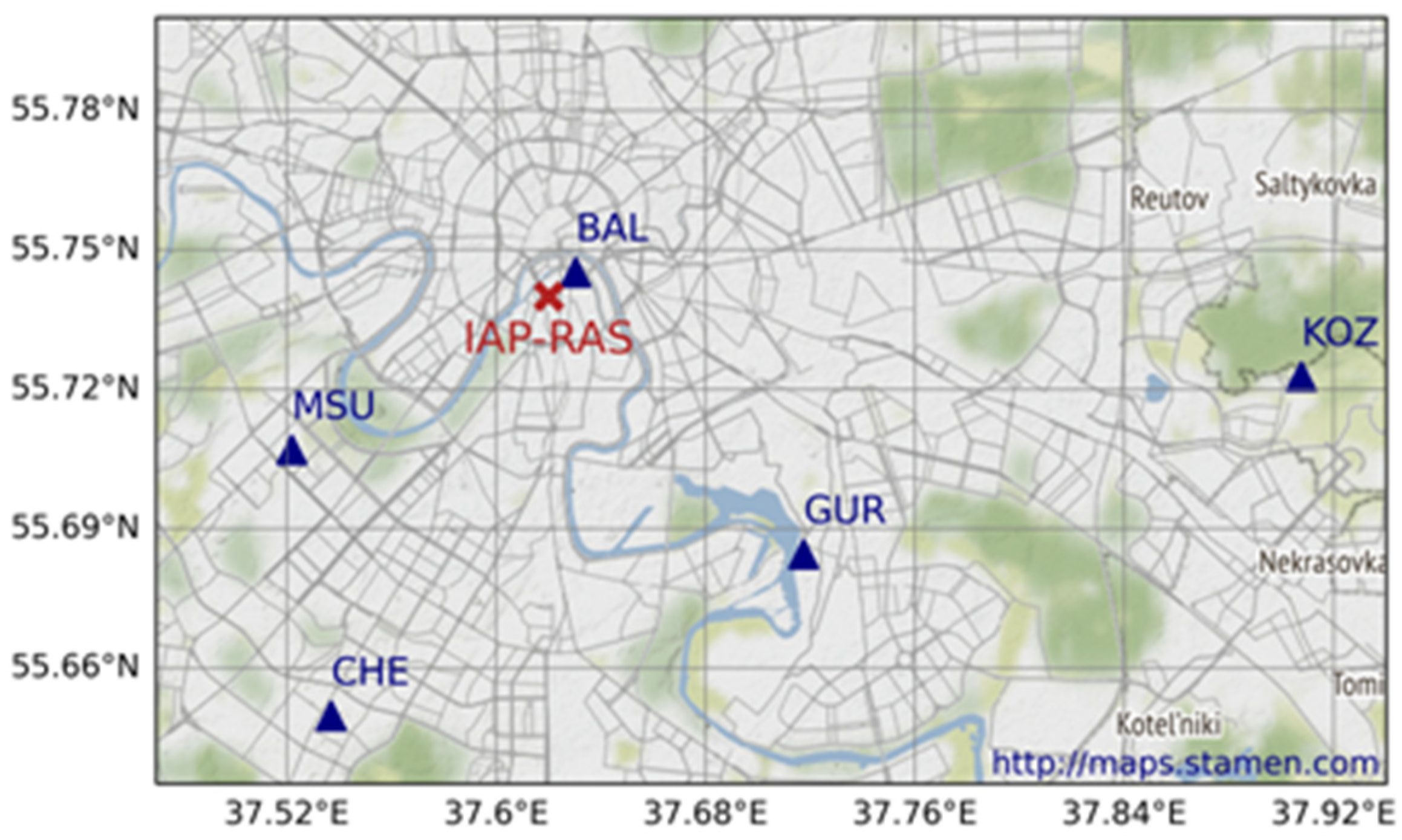

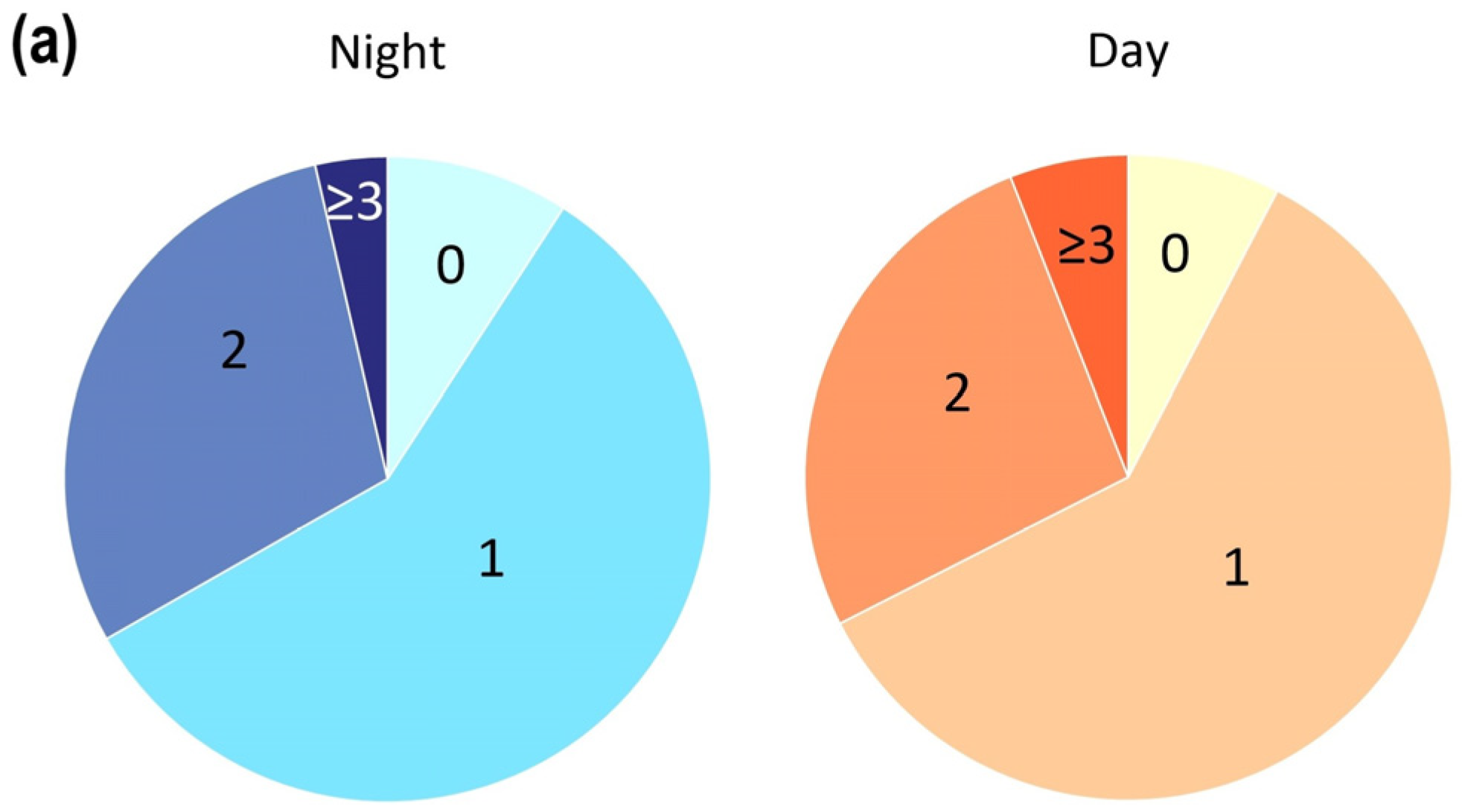
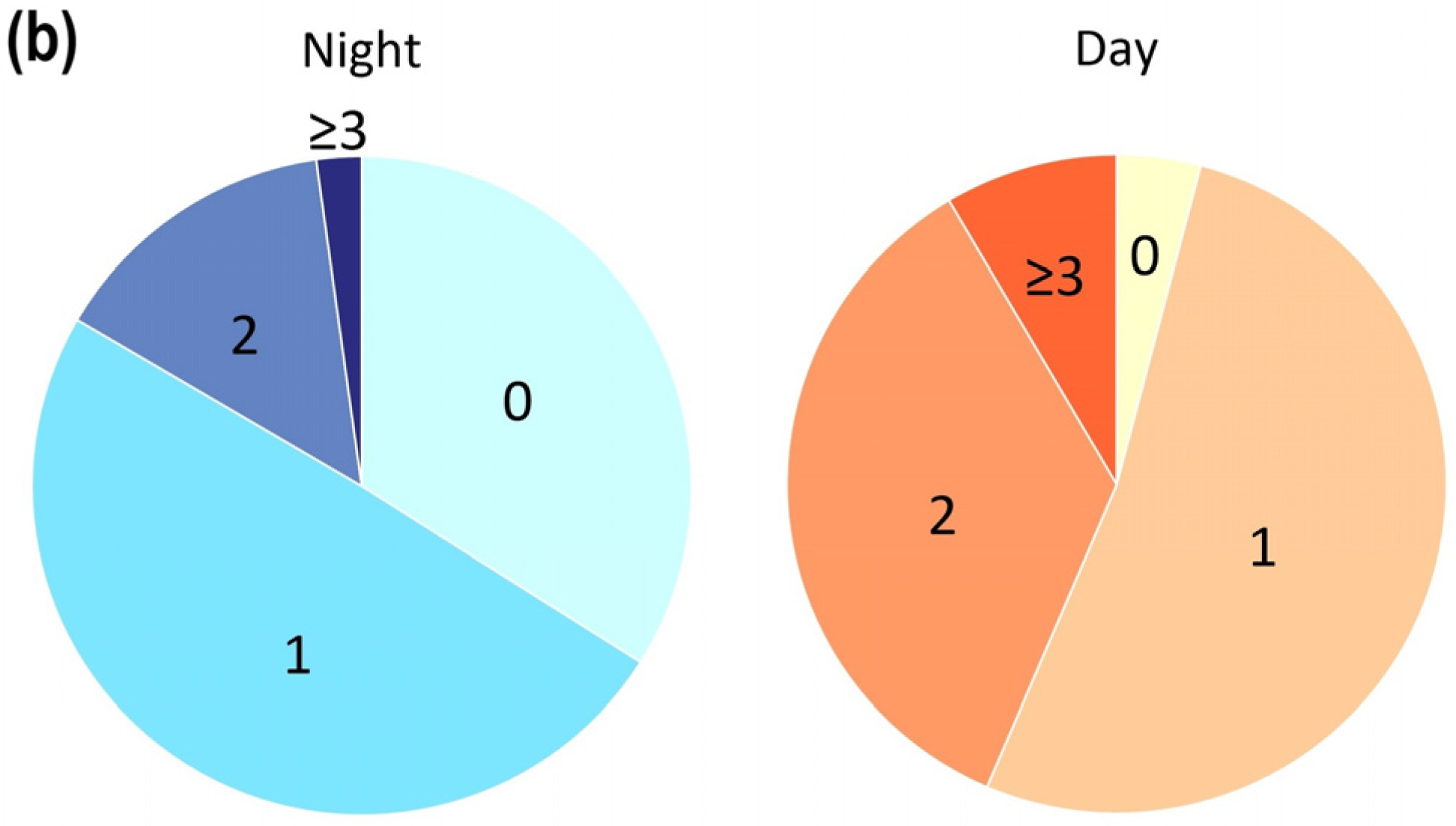
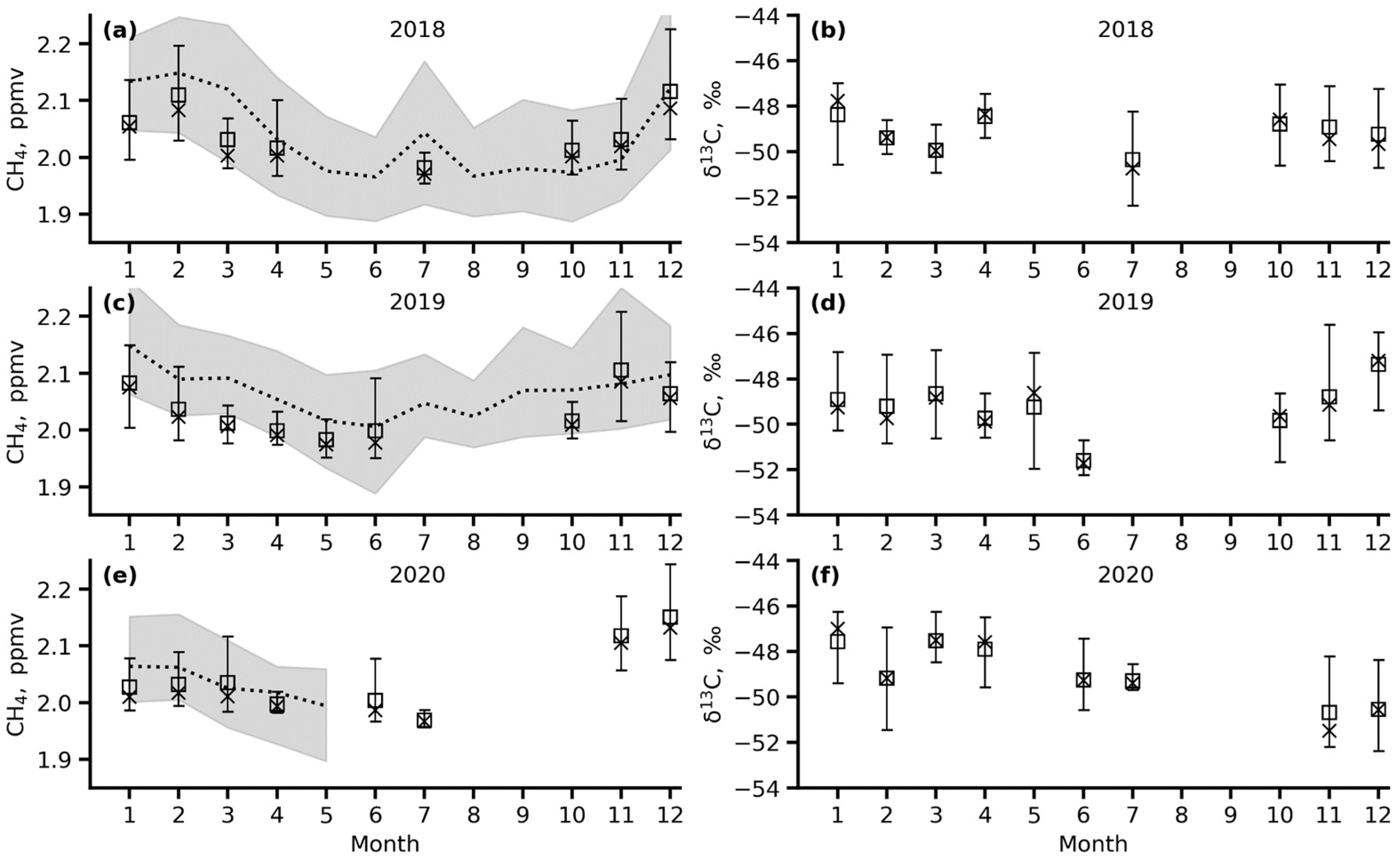


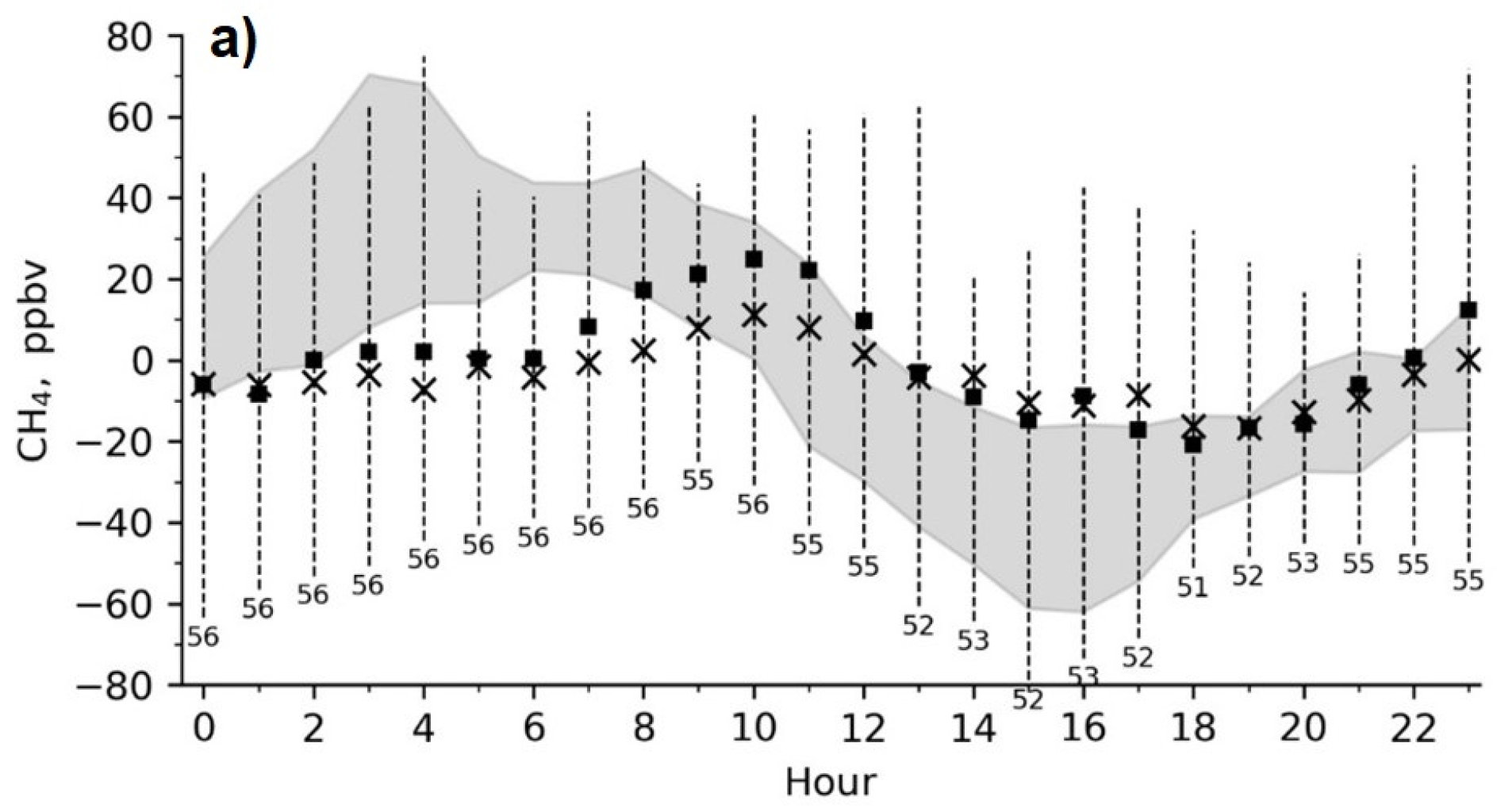


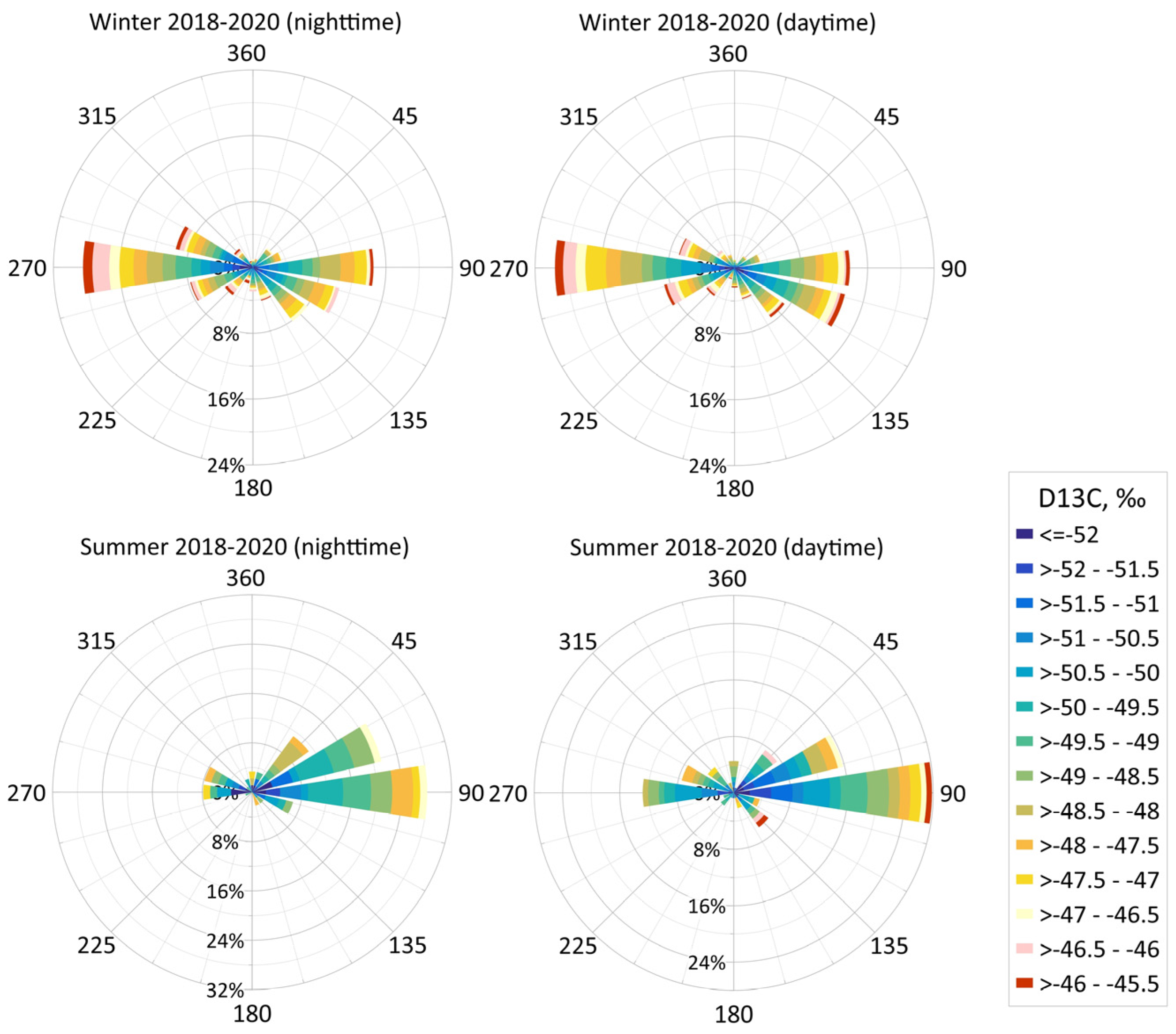
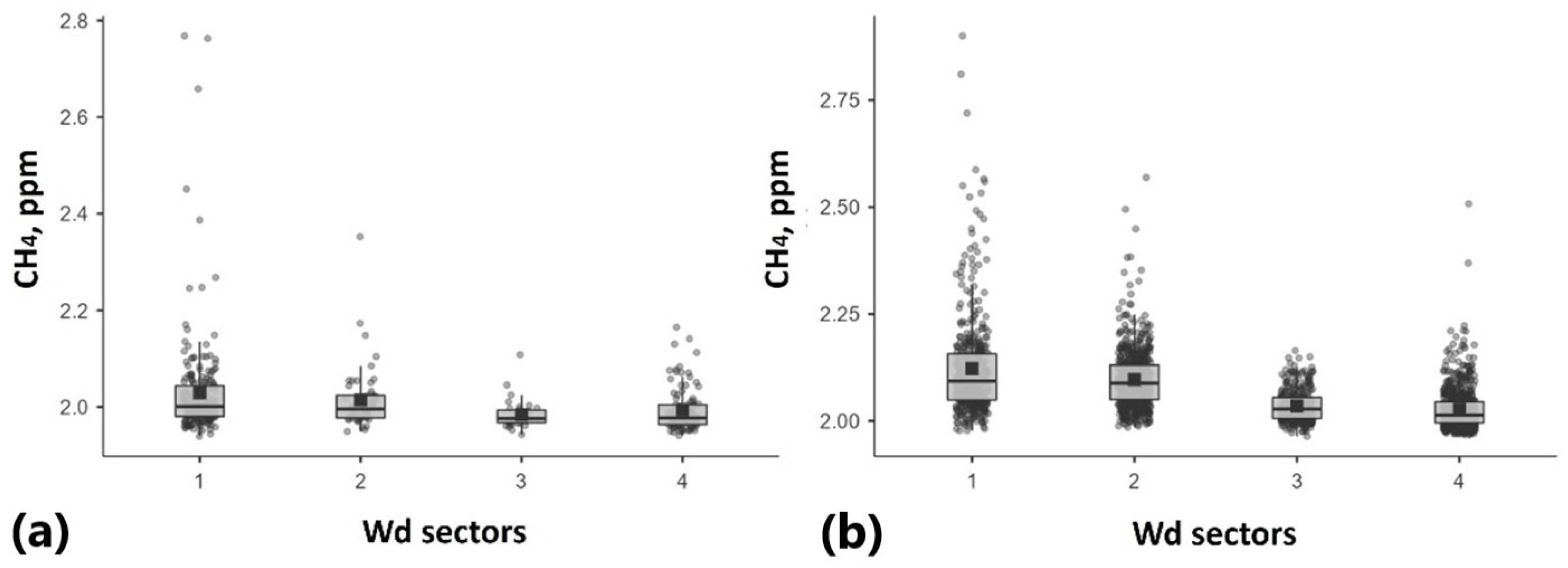
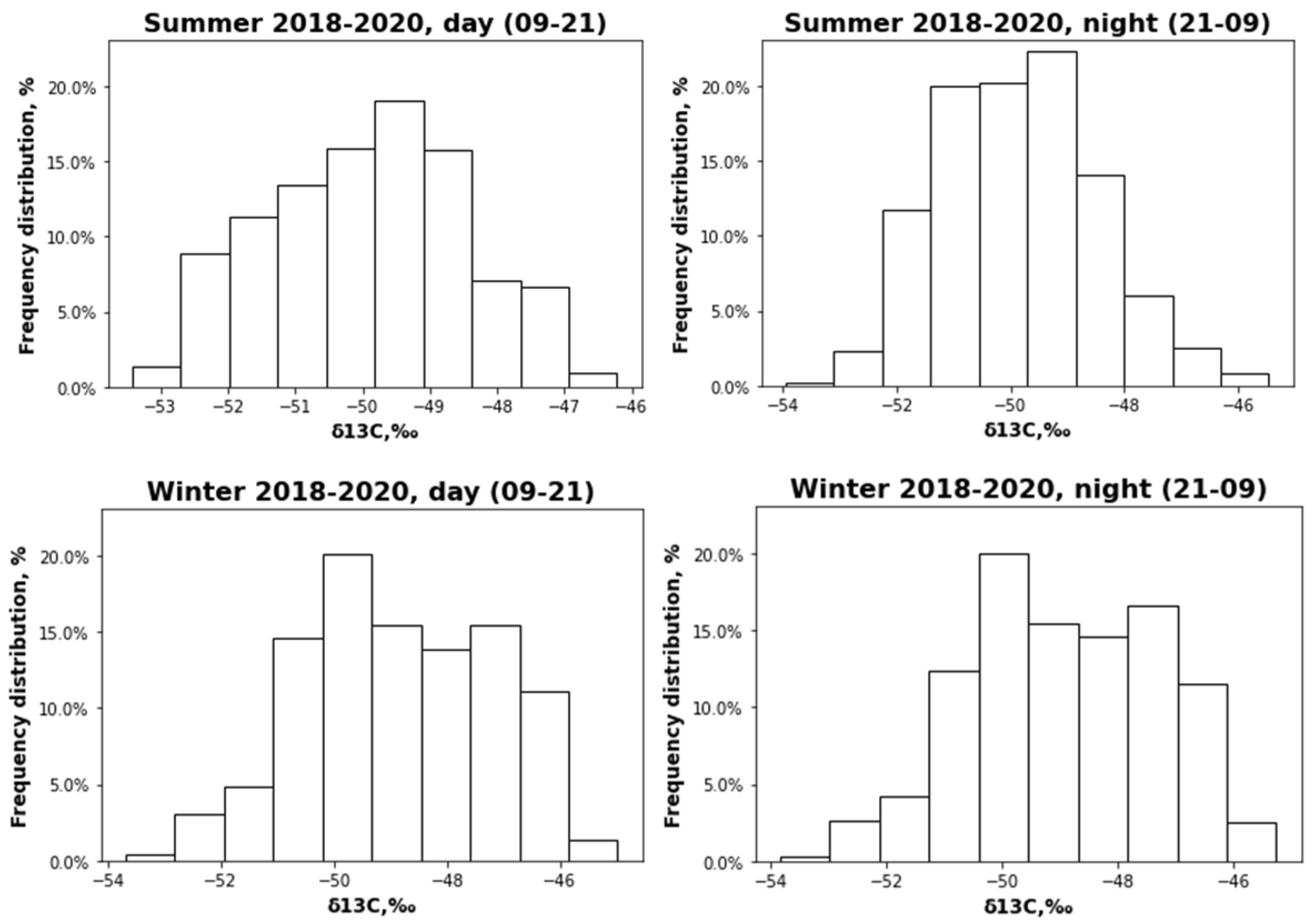


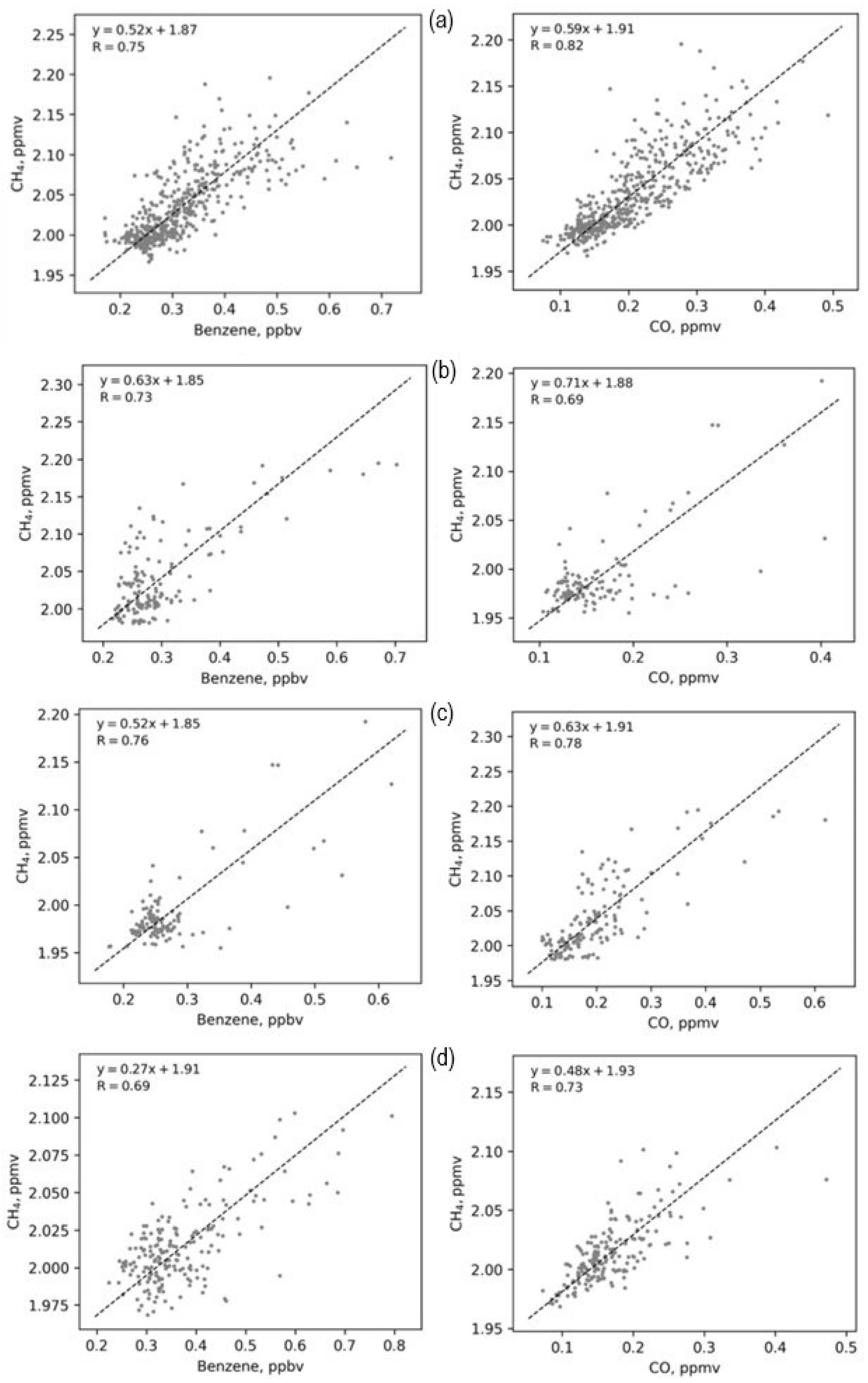

| Source | δ13CH4, ‰ | Reference | Location |
|---|---|---|---|
| Biomass burning | −24–−32 | [16] | USA (Florida) |
| −26.2 ± 4.8 | [17] | Hungary (Budapest) | |
| Gas storage sites | −43.4 ± 0.5– −33.8 ± 0.3 | [18] | France (Paris) |
| Natural gas facilities | −41.7 ± 0.7– −49.7 ± 0.7 | [15] | Canada (Alberta) |
| Fossil fuel sources | −15–−45 | [17] | Hungary (Budapest) |
| Gas leaks | −36 ± 2 | [4] | Great Britain (London) |
| Coal mines | −51.2 ± 0.3– −30.9 ± 1.4 | [4] | Great Britain (London) |
| Subarctic wetlands | −68.5 ± 0.7 | [10] | Finland (Lompolojänkkä) |
| Modern microbial sources | −61.7 ± 6.2 | [17] | Hungary (Budapest) |
| Biogenic emissions | −55–−70 | [17] | Hungary (Budapest) |
| Landfills | −55.3 ± 0.2 | [15] | Canada (winter) |
| −63.7 ± 0.3–−58.2 ± 0.3 | [18] | France (Paris) | |
| −58 ± 3 | [4] | Great Britain (London) | |
| −64.4–−44.3 | [11] | Great Britain, Netherlands, Turkey | |
| Aeration station | −53.7 ± 0.1 | [11] | Great Britain, Netherlands, Turkey |
| Oil storage | −54.9 ± 2.9– −60.6 ± 0.6 | [18] | France (Paris) |
| Season | [CH4] | [CO] | ∆[CH4]auto | ∆[CH4]micro+ |
|---|---|---|---|---|
| Winter | 2033 ± 43 | 206 ± 76 | 0.17 ± 0.08 | 40.8 ± 97.9 |
| Spring | 2038 ± 53 | 199 ± 83 | 0.18 ± 0.09 | 42.8 ± 124.8 |
| Summer | 1992 ± 39 | 163 ± 56 | 0.14 ± 0.09 | 15.9 ± 91.7 |
| Autumn | 2013 ± 26 | 167 ± 54 | 0.10 ± 0.10 | 25.9 ± 48.5 |
| Season | [CH4]base | [CO]base | ∆[CH4]W | ∆[CO]W |
|---|---|---|---|---|
| Winter | 1992 ± 88 | 141 ± 25 | 41 | 18 |
| Spring | 1995 ± 113 | 143 ± 24 | 46 | 11 |
| Summer | 1976 ± 83 | 135 ± 19 | 51 | 41 |
| Autumn | 1987 ± 41 | 115 ± 08 | 38 | 3 |
Disclaimer/Publisher’s Note: The statements, opinions and data contained in all publications are solely those of the individual author(s) and contributor(s) and not of MDPI and/or the editor(s). MDPI and/or the editor(s) disclaim responsibility for any injury to people or property resulting from any ideas, methods, instructions or products referred to in the content. |
© 2023 by the authors. Licensee MDPI, Basel, Switzerland. This article is an open access article distributed under the terms and conditions of the Creative Commons Attribution (CC BY) license (https://creativecommons.org/licenses/by/4.0/).
Share and Cite
Berezina, E.; Vasileva, A.; Moiseenko, K.; Pankratova, N.; Skorokhod, A.; Belikov, I.; Belousov, V. Atmospheric CH4 and Its Isotopic Composition (δ13C) in Urban Environment in the Example of Moscow, Russia. Atmosphere 2023, 14, 830. https://doi.org/10.3390/atmos14050830
Berezina E, Vasileva A, Moiseenko K, Pankratova N, Skorokhod A, Belikov I, Belousov V. Atmospheric CH4 and Its Isotopic Composition (δ13C) in Urban Environment in the Example of Moscow, Russia. Atmosphere. 2023; 14(5):830. https://doi.org/10.3390/atmos14050830
Chicago/Turabian StyleBerezina, Elena, Anastasia Vasileva, Konstantin Moiseenko, Natalia Pankratova, Andrey Skorokhod, Igor Belikov, and Valery Belousov. 2023. "Atmospheric CH4 and Its Isotopic Composition (δ13C) in Urban Environment in the Example of Moscow, Russia" Atmosphere 14, no. 5: 830. https://doi.org/10.3390/atmos14050830




